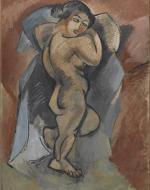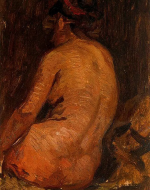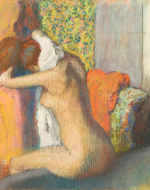Created by Adrianna Walker on Sun, 02/25/2024 - 21:39
Description:
Display Note:
These works of art all collectively speak the same message. That message is that the natural female body is to be appreciated. These artists, I believe, would want their message to be seen as timeless. Movement also collectively plays a role in each piece as well and I find that this should be visualized. Therefore, I would want to show their art while showing that the message is still important today and the aspect of movement that they used is appreciated.
I would display the art on three walls in a room of museum. The walls would preferably be white to not distract from the art. I would use a neutral white light to display each piece. The museum I would want this installation placed in would preferably be a museum focused on female sexuality as this is a message on the appreciation of the female form. Each piece would have its own wall to be displayed on.
Then, to incorporate the timelessness and the movement of these works of art, I would ask three female actresses to be a part of the display. Each actress would be assigned to display themselves in front of their piece. They would be asked to replicate the piece.
For the Braque piece, I would ask the actress to stand, nude, with her face, but eyes closed, to the audience with her body facing the right. I would ask her to hold this pose while holding a blue cloth piece that would surround her with her hands behind her head to replicate the essence of the art piece. To show the movement, I would ask her to move the blue piece around herself.
For the Picasso piece, I would ask the actress to sit, nude, on the floor, with her back to the audience and with her body tilted slightly to the left. To incorporate the movement seen in the Picasso’s work, I would ask her to occasionally move from sitting straight to sitting at a tilt to emphasize the power of the tilted pose. To replicate Picasso’s essence, I would shine an orange light onto her body, making it so she is seen as the light just like the subject.
To replicate Degas’s piece, I would have the actress sit on a seat resembling what the subject is sitting on in the work. I would ask her to sit with the side of her body facing the audience. I would provide her a towel and ask her to recreate the drying of her neck as seen in the art piece to show the movement.
This would give a modern look to the art as I would incorporate female bodies of today. This means I would find women that represent women of today’s society which would include different ethnicities, different body types, and disabled women. I find that showing the modern women of today would encapsulate the feeling of timelessness as they recreate the poses of art before them. It would add to the appreciation of the female body as it would show that the female body is more appreciated than it ever was before as more women are being seen than before. Also, with the use of actresses, I can show the audience the power that the use of movement in these pieces holds as it further emphasizes the naturalness of the female body.
In conclusion, I would display my installation in a museum with the pieces on the walls and the actresses recreating the pieces in front of them. This would create a feeling of timelessness and emphasize the movement of each piece
Installation Note:
Braque, Degas, and Picasso collectively celebrate the female body within their works of art in this installation. Each artist appreciates the female form with their own art style.
In Le Grand Nu, the female body is seen to be embraced with movement as the subject has her foot raised. The lines of shape surrounding her also suggest movement as they seem to be flowing throughout the piece, more specifically flowing around her. The cool blue colors surrounding her as well as the hue of red in the background bring the viewer a feeling of happiness. Her body is given detail as the piece shows the side of her breast, the curve of her back that flows into the curves of her buttocks, and the protuberance of her stomach. Such details provide the viewer with the natural form of a woman. The expression of the subject, her eyes closed as she faces the viewer, tells the viewer she isn’t paying attention to the viewer looking at her, which can be interpreted as her having confidence in herself. Although her face is shown, it isn’t given much detail, providing the viewer with the opportunity to see the subject as any woman. This feature allows the viewer to make their own personal connection to the piece, making the message one they can relate to themselves.
Picasso’s art is often dark. However, even with that darkness, the appreciation of the female form is still evident in Female nude from Back. The background is dark, but the light of the piece is focused on the subject, making her the center of the piece. This detail gives the viewer a feeling of warmth and light at the same time due to the darkness of the background and light on the subject. Movement, just like with Braque’s piece, is suggested in this work as well as the woman appears to be slouched over as her body is at a tilt. This movement allows the viewer to take in the subject in her natural form as the side of her breast, curve of her back, the curves of her stomach, and redness of her buttocks, most likely from the subject sitting for a long period of time, can be seen. One cannot see the face of the subject, allowing the viewer to view the subject as any woman as seen in Braque’s piece.
In Degas’s piece, After the Bath, Female Drying her nape, the work of art appears more natural than the other pieces as the woman is not the center of the piece. This is because of the subject sitting more to the left of the piece, rather than the middle as seen in Picasso’s and Braque’s work. The colors are bright and inviting as Degas uses green, orange, and yellow. These colors emulate happiness. These colors are inviting the viewer to look at the image. More specifically, the colors invite the viewer to look at the subject as they are surrounding her. The use of the subject holding a towel suggests movement, an aspect seen in all these pieces of art in the installation. Naturalness is emphasized as the side of her breast, curve of her stomach, and redness of her buttocks from sitting can be seen in this work. Unlike Braque and Picasso who centered their piece around the subject entirely, Degas appreciates the female form in the setting of a natural scene as the woman is carrying out a task. Just like Braque and Picasso, Degas doesn’t show the face of the woman, which allows the viewer to see the woman as any woman.
Braque, Picasso, and Degas all ask its viewer to do the same; appreciate the female body in its natural form.
Works Cited
Braque, Georges. Le Grande Nu. 1908. Musée National d’Arte Moderne, Centre Pompidou, Paris. https://en.wikipedia.org/wiki/Georges_Braque#/media/File:Georges_Braque,...(Le_Grand_Nu, Large_Nude),_oil_on_canvas,_140_×_100_cm,_Musée_National_d'Art_Moderne, Centre_Pompidou,_Paris.jpg. Accessed 14 February 2024.
Degas, Edgar. After the Bath, Woman Drying her Nape. 1898. Musée d’Orsay, Paris. https://en.wikipedia.org/wiki/Edgar_Degas#/media/File:Edgar_Germain_Hila.... Accessed Jan 2023.
Picasso, Pablo. Female nude from back. 1895. Museu Picasso, Barcelona, Spain https://www.wikiart.org/en/pablo-picasso/female-nude-from-back-1895. Accessed 14 February 2024.
Copyright:
Associated Place(s)
Featured in Exhibit:
Artist:
- Multiple Artists




